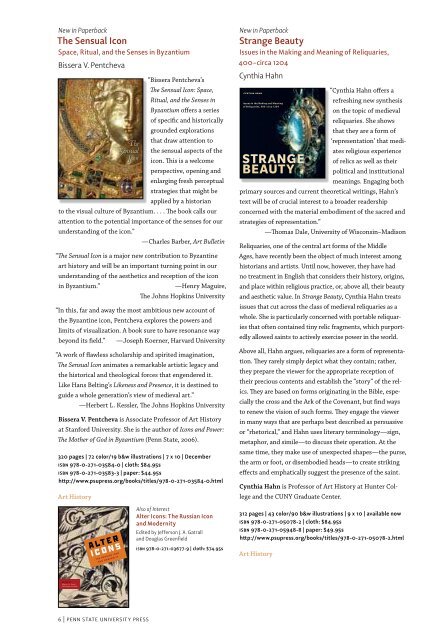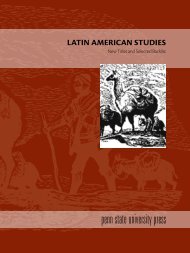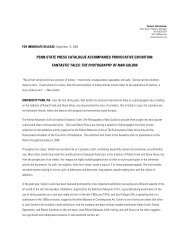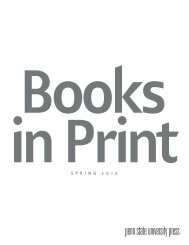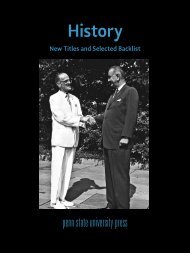Download the Catalog - Pennsylvania State University Press
Download the Catalog - Pennsylvania State University Press
Download the Catalog - Pennsylvania State University Press
Create successful ePaper yourself
Turn your PDF publications into a flip-book with our unique Google optimized e-Paper software.
6 | penn state university press 1-800-326-9180 | 7<br />
New in Paperback<br />
The Sensual Icon<br />
Space, Ritual, and <strong>the</strong> Senses in Byzantium<br />
Bissera V. Pentcheva<br />
“Bissera Pentcheva’s<br />
The Sensual Icon: Space,<br />
Ritual, and <strong>the</strong> Senses in<br />
Byzantium offers a series<br />
of specific and historically<br />
grounded explorations<br />
that draw attention to<br />
<strong>the</strong> sensual aspects of <strong>the</strong><br />
icon. This is a welcome<br />
perspective, opening and<br />
enlarging fresh perceptual<br />
strategies that might be<br />
applied by a historian<br />
to <strong>the</strong> visual culture of Byzantium. . . . The book calls our<br />
attention to <strong>the</strong> potential importance of <strong>the</strong> senses for our<br />
understanding of <strong>the</strong> icon.”<br />
<br />
—Charles Barber, Art Bulletin<br />
“The Sensual Icon is a major new contribution to Byzantine<br />
art history and will be an important turning point in our<br />
understanding of <strong>the</strong> aes<strong>the</strong>tics and reception of <strong>the</strong> icon<br />
in Byzantium.”<br />
—Henry Maguire,<br />
<br />
The Johns Hopkins <strong>University</strong><br />
“In this, far and away <strong>the</strong> most ambitious new account of<br />
<strong>the</strong> Byzantine icon, Pentcheva explores <strong>the</strong> powers and<br />
limits of visualization. A book sure to have resonance way<br />
beyond its field.”<br />
—Joseph Koerner, Harvard <strong>University</strong><br />
“A work of flawless scholarship and spirited imagination,<br />
The Sensual Icon animates a remarkable artistic legacy and<br />
<strong>the</strong> historical and <strong>the</strong>ological forces that engendered it.<br />
Like Hans Belting’s Likeness and Presence, it is destined to<br />
guide a whole generation’s view of medieval art.”<br />
<br />
—Herbert L. Kessler, The Johns Hopkins <strong>University</strong><br />
Bissera V. Pentcheva is Associate Professor of Art History<br />
at Stanford <strong>University</strong>. She is <strong>the</strong> author of Icons and Power:<br />
The Mo<strong>the</strong>r of God in Byzantium (Penn <strong>State</strong>, 2006).<br />
320 pages | 72 color/19 b&w illustrations | 7 x 10 | December<br />
isbn 978-0-271-03584-0 | cloth: $84.95s<br />
isbn 978-0-271-03583-3 | paper: $44.95s<br />
http://www.psupress.org/books/titles/978-0-271-03584-0.html<br />
Art History<br />
New in Paperback<br />
Strange Beauty<br />
Issues in <strong>the</strong> Making and Meaning of Reliquaries,<br />
400–circa 1204<br />
Cynthia Hahn<br />
“Cynthia Hahn offers a<br />
refreshing new syn<strong>the</strong>sis<br />
on <strong>the</strong> topic of medieval<br />
reliquaries. She shows<br />
that <strong>the</strong>y are a form of<br />
‘representation’ that mediates<br />
religious experience<br />
of relics as well as <strong>the</strong>ir<br />
political and institutional<br />
meanings. Engaging both<br />
primary sources and current <strong>the</strong>oretical writings, Hahn’s<br />
text will be of crucial interest to a broader readership<br />
concerned with <strong>the</strong> material embodiment of <strong>the</strong> sacred and<br />
strategies of representation.”<br />
<br />
—Thomas Dale, <strong>University</strong> of Wisconsin–Madison<br />
Reliquaries, one of <strong>the</strong> central art forms of <strong>the</strong> Middle<br />
Ages, have recently been <strong>the</strong> object of much interest among<br />
historians and artists. Until now, however, <strong>the</strong>y have had<br />
no treatment in English that considers <strong>the</strong>ir history, origins,<br />
and place within religious practice, or, above all, <strong>the</strong>ir beauty<br />
and aes<strong>the</strong>tic value. In Strange Beauty, Cynthia Hahn treats<br />
issues that cut across <strong>the</strong> class of medieval reliquaries as a<br />
whole. She is particularly concerned with portable reliquaries<br />
that often contained tiny relic fragments, which purportedly<br />
allowed saints to actively exercise power in <strong>the</strong> world.<br />
Above all, Hahn argues, reliquaries are a form of representation.<br />
They rarely simply depict what <strong>the</strong>y contain; ra<strong>the</strong>r,<br />
<strong>the</strong>y prepare <strong>the</strong> viewer for <strong>the</strong> appropriate reception of<br />
<strong>the</strong>ir precious contents and establish <strong>the</strong> “story” of <strong>the</strong> relics.<br />
They are based on forms originating in <strong>the</strong> Bible, especially<br />
<strong>the</strong> cross and <strong>the</strong> Ark of <strong>the</strong> Covenant, but find ways<br />
to renew <strong>the</strong> vision of such forms. They engage <strong>the</strong> viewer<br />
in many ways that are perhaps best described as persuasive<br />
or “rhetorical,” and Hahn uses literary terminology—sign,<br />
metaphor, and simile—to discuss <strong>the</strong>ir operation. At <strong>the</strong><br />
same time, <strong>the</strong>y make use of unexpected shapes—<strong>the</strong> purse,<br />
<strong>the</strong> arm or foot, or disembodied heads—to create striking<br />
effects and emphatically suggest <strong>the</strong> presence of <strong>the</strong> saint.<br />
Cynthia Hahn is Professor of Art History at Hunter College<br />
and <strong>the</strong> CUNY Graduate Center.<br />
312 pages | 43 color/90 b&w illustrations | 9 x 10 | available now<br />
isbn 978-0-271-05078-2 | cloth: $84.95s<br />
isbn 978-0-271-05948-8 | paper: $49.95s<br />
http://www.psupress.org/books/titles/978-0-271-05078-2.html<br />
Art History<br />
The<br />
Sensual<br />
Icon<br />
The<br />
Sensual<br />
Icon<br />
Bissera V. PentcheVa<br />
Bissera V. PentcheVa<br />
Space, Ritual, and <strong>the</strong> Senses in Byzantium<br />
Space, Ritual, and <strong>the</strong> Senses in Byzantium<br />
Issues in <strong>the</strong> Making and Meaning<br />
of Reliquaries, 400–circa 1204<br />
STRANGE<br />
BEAUTY<br />
CYNTHIA HAHN<br />
Also of Interest<br />
Translating Nature into Art:<br />
Holbein, <strong>the</strong> Reformation, and<br />
Renaissance Rhetoric<br />
Jeanne Nuechterlein<br />
isbn 978-0-271-03692-2 | cloth: $84.95s<br />
Also of Interest<br />
Alter Icons: The Russian Icon<br />
and Modernity<br />
Edited by Jefferson J. A. Gatrall<br />
and Douglas Greenfield<br />
isbn 978-0-271-03677-9 | cloth: $74.95s<br />
Holbein’s models, particularly <strong>the</strong>ir geographic diversity, must surely have marked an extreme for <strong>the</strong> time.It is difficult<br />
to know that for certain, since for most German Renaissance artists few identifiable youthful works survive, whe<strong>the</strong>r<br />
Holbein’s models, particularly <strong>the</strong>ir geographic diversity, must surely have marked an extreme for <strong>the</strong> time.It is difficult<br />
to know that for certain, since for most German Renaissance artists few identifiable youthful works survive, whe<strong>the</strong>r<br />
Holbein’s models, particularly <strong>the</strong>ir geographic diversity, must surely have marked an extreme for <strong>the</strong> time.It is difficult<br />
independent images or workshop products to which <strong>the</strong>y verifiably contributed. In <strong>the</strong> cases of Cranach and §ltdorfer,<br />
to know that for certain, since for most German Renaissance artists few identifiable youthful works survive, whe<strong>the</strong>r<br />
independent images or workshop products to which <strong>the</strong>y verifiably contributed. In <strong>the</strong> cases of Cranach and §ltdorfer,<br />
to know that for certain, since for most German Renaissance artists few identifiable youthful works survive, whe<strong>the</strong>r<br />
for example, <strong>the</strong>ir lives and works remain a virtual mystery before about age twenty-five or thirty. Dürer is a major<br />
independent images or workshop products to which <strong>the</strong>y verifiably contributed. In <strong>the</strong> cases of Cranach and §ltdorfer,<br />
for example, <strong>the</strong>ir lives and works remain a virtual mystery before about age twenty-five or thirty. Dürer is a major<br />
independent images or workshop products to which <strong>the</strong>y verifiably contributed. In <strong>the</strong> cases of Cranach and §ltdorfer,<br />
exception, since several of his extant drawings, watercolors, and paintings predate <strong>the</strong> establishment of his workshop in 1495,<br />
for example, <strong>the</strong>ir lives and works remain a virtual mystery before about age twenty-five or thirty. Dürer is a major<br />
exception, since several of his extant drawings, watercolors, and paintings predate <strong>the</strong> establishment of his workshop in 1495,<br />
for example, <strong>the</strong>ir lives and works remain a virtual mystery before about age twenty-five or thirty. Dürer is a major<br />
when he was twenty-four years old, and a great many date from his first couple years as an independent master; all of <strong>the</strong>m<br />
exception, since several of his extant drawings, watercolors, and paintings predate <strong>the</strong> establishment of his workshop in 1495,<br />
when he was twenty-four years old, and a great many date from his first couple years as an independent master; all of <strong>the</strong>m<br />
exception, since several of his extant drawings, watercolors, and paintings predate <strong>the</strong> establishment of his workshop in 1495,<br />
evince his youthful precocity and his engagement with diverse artistic traditions. In <strong>the</strong> case of Holbein a generation later,<br />
when he was twenty-four years old, and a great many date from his first couple years as an independent master; all of <strong>the</strong>m<br />
evince his youthful precocity and his engagement with diverse artistic traditions. In <strong>the</strong> case of Holbein a generation later,<br />
when he was twenty-four years old, and a great many date from his first couple years as an independent master; all of <strong>the</strong>m<br />
a consistent sequence of extant datable work starts in his late teens, tracing <strong>the</strong> process of his early development in reasonab<br />
evince his youthful precocity and his engagement with diverse artistic traditions. In <strong>the</strong> case of Holbein a generation later,<br />
a consistent sequence of extant datable work starts in his late teens, tracing <strong>the</strong> process of his early development in reasonab<br />
evince his youthful precocity and his engagement with diverse artistic traditions. In <strong>the</strong> case of Holbein a generation later,<br />
good detail. §lthough knowledge about artists’ workshop training is still limited, it is evident that Holbein’s concern for<br />
a consistent sequence of extant datable work starts in his late teens, tracing <strong>the</strong> process of his early development in reasonab<br />
good detail. §lthough knowledge about artists’ workshop training is still limited, it is evident that Holbein’s concern for<br />
a consistent sequence of extant datable work starts in his late teens, tracing <strong>the</strong> process of his early development in reasonab<br />
variety paralleled <strong>the</strong> latest humanist approach to teaching young writers, who learned to develop proficiency by inventively<br />
good detail. §lthough knowledge about artists’ workshop training is still limited, it is evident that Holbein’s concern for<br />
variety paralleled <strong>the</strong> latest humanist approach to teaching young writers, who learned to develop proficiency by inventively<br />
good detail. §lthough knowledge about artists’ workshop training is still limited, it is evident that Holbein’s concern for<br />
imitating a range of models. Given Holbein’s early and close connections with <strong>the</strong> humanist scholars and publishers in<br />
variety paralleled <strong>the</strong> latest humanist approach to teaching young writers, who learned to develop proficiency by inventively<br />
imitating a range of models. Given Holbein’s early and close connections with <strong>the</strong> humanist scholars and publishers in<br />
variety paralleled <strong>the</strong> latest humanist approach to teaching young writers, who learned to develop proficiency by inventively<br />
Basel—indeed <strong>the</strong> connections more broadly between Nor<strong>the</strong>rn art and humanism in this period—that parallel was<br />
imitating a range of models. Given Holbein’s early and close connections with <strong>the</strong> humanist scholars and publishers in<br />
Basel—indeed <strong>the</strong> connections more broadly between Nor<strong>the</strong>rn art and humanism in this period—that parallel was<br />
imitating a range of models. Given Holbein’s early and close connections with <strong>the</strong> humanist scholars and publishers in<br />
surely not a coincidence. §s he matured into his mid-twenties, Holbein’s once highly varied styles became more consistent<br />
Basel—indeed <strong>the</strong> connections more broadly between Nor<strong>the</strong>rn art and humanism in this period—that parallel was<br />
surely not a coincidence. §s he matured into his mid-twenties, Holbein’s once highly varied styles became more consistent<br />
Basel—indeed <strong>the</strong> connections more broadly between Nor<strong>the</strong>rn art and humanism in this period—that parallel was<br />
and consolidated, revealing greater concern for <strong>the</strong> meanings inherent within particular visual styles. Here again this<br />
surely not a coincidence. §s he matured into his mid-twenties, Holbein’s once highly varied styles became more consistent<br />
and consolidated, revealing greater concern for <strong>the</strong> meanings inherent within particular visual styles. Here again this<br />
surely not a coincidence. §s he matured into his mid-twenties, Holbein’s once highly varied styles became more consistent<br />
development bears many important parallels with <strong>the</strong> stylistic decisions faced by contemporary writers: in an era when humanists<br />
and consolidated, revealing greater concern for <strong>the</strong> meanings inherent within particular visual styles. Here again this<br />
development bears many important parallels with <strong>the</strong> stylistic decisions faced by contemporary writers: in an era when humanists<br />
and consolidated, revealing greater concern for <strong>the</strong> meanings inherent within particular visual styles. Here again this<br />
were rethinking <strong>the</strong> role of language, and religious opponents were becoming increasingly suspicious of rhetorical manipulation,<br />
development bears many important parallels with <strong>the</strong> stylistic decisions faced by contemporary writers: in an era when humanists<br />
were rethinking <strong>the</strong> role of language, and religious opponents were becoming increasingly suspicious of rhetorical manipulation,<br />
development bears many important parallels with <strong>the</strong> stylistic decisions faced by contemporary writers: in an era when humanists<br />
style of expression necessarily became an essential component of meaning, not an arbitrary or incidental form of decoration.<br />
were rethinking <strong>the</strong> role of language, and religious opponents were becoming increasingly suspicious of rhetorical manipulation,<br />
style of expression necessarily became an essential component of meaning, not an arbitrary or incidental form of decoration.<br />
were rethinking <strong>the</strong> role of language, and religious opponents were becoming increasingly suspicious of rhetorical manipulation,<br />
This is why, I believe, Holbein’s more mature works became less concerned with diversity as a goal and instead focused<br />
style of expression necessarily became an essential component of meaning, not an arbitrary or incidental form of decoration.<br />
This is why, I believe, Holbein’s more mature works became less concerned with diversity as a goal and instead focused<br />
style of expression necessarily became an essential component of meaning, not an arbitrary or incidental form of decoration.<br />
more thoughtfully on how visual construction shapes interpretation. §nd it was through that concern that he came to distinguish<br />
This is why, I believe, Holbein’s more mature works became less concerned with diversity as a goal and instead focused<br />
more thoughtfully on how visual construction shapes interpretation. §nd it was through that concern that he came to distinguish<br />
This is why, I believe, Holbein’s more mature works became less concerned with diversity as a goal and instead focused<br />
more thoughtfully on how visual construction shapes interpretation. §nd it was through that concern that he came to distinguish<br />
between a mode that acknowledged its own inventiveness, applied primarily to <strong>the</strong> artist’s retelling of historical, mythological<br />
more thoughtfully on how visual construction shapes interpretation. §nd it was through that concern that he came to distinguish<br />
period in Basel. That may in part be due to <strong>the</strong> fact that he moved away at a relatively young age, so that only by <strong>the</strong><br />
time of his later career in London, specializing in portraiture and metalwork design, did his images develop more consistency.<br />
period in Basel. That may in part be due to <strong>the</strong> fact that he moved away at a relatively young age, so that only by <strong>the</strong><br />
time of his later career in London, specializing in portraiture and metalwork design, did his images develop more consistency.<br />
period in Basel. That may in part be due to <strong>the</strong> fact that he moved away at a relatively young age, so that only by <strong>the</strong><br />
In his earlier years, exploring <strong>the</strong> diversity of contemporary stylistic possibilities was more important in his work than<br />
time of his later career in London, specializing in portraiture and metalwork design, did his images develop more consistency.<br />
In his earlier years, exploring <strong>the</strong> diversity of contemporary stylistic possibilities was more important in his work than<br />
time of his later career in London, specializing in portraiture and metalwork design, did his images develop more consistency.<br />
establishing a distinctive personal style. It was only by his mid- to late twenties, especially following his trip to France,<br />
In his earlier years, exploring <strong>the</strong> diversity of contemporary stylistic possibilities was more important in his work than<br />
establishing a distinctive personal style. It was only by his mid- to late twenties, especially following his trip to France,<br />
In his earlier years, exploring <strong>the</strong> diversity of contemporary stylistic possibilities was more important in his work than<br />
that he consolidated this range into two generally consistent modes of representation, <strong>the</strong> inventive and <strong>the</strong> descriptive.Holbei<br />
establishing a distinctive personal style. It was only by his mid- to late twenties, especially following his trip to France,<br />
that he consolidated this range into two generally consistent modes of representation, <strong>the</strong> inventive and <strong>the</strong> descriptive.Holbei<br />
establishing a distinctive personal style. It was only by his mid- to late twenties, especially following his trip to France,<br />
mature inventive style deftly assimilated diverse visual traditions, reinterpreted and unified by a remarkable technical virtuos<br />
that he consolidated this range into two generally consistent modes of representation, <strong>the</strong> inventive and <strong>the</strong> descriptive.Holbei<br />
mature inventive style deftly assimilated diverse visual traditions, reinterpreted and unified by a remarkable technical virtuos<br />
that he consolidated this range into two generally consistent modes of representation, <strong>the</strong> inventive and <strong>the</strong> descriptive.Holbei<br />
Images like <strong>the</strong> Icones woodcuts blend <strong>the</strong> best of Nor<strong>the</strong>rn and Sou<strong>the</strong>rn approaches: technical agility, supreme elegance,<br />
mature inventive style deftly assimilated diverse visual traditions, reinterpreted and unified by a remarkable technical virtuos<br />
Images like <strong>the</strong> Icones woodcuts blend <strong>the</strong> best of Nor<strong>the</strong>rn and Sou<strong>the</strong>rn approaches: technical agility, supreme elegance,<br />
mature inventive style deftly assimilated diverse visual traditions, reinterpreted and unified by a remarkable technical virtuos<br />
creative ingenuity. Before he arrived at this consolidation, however, Holbein explored a range of stylistic models in<br />
Images like <strong>the</strong> Icones woodcuts blend <strong>the</strong> best of Nor<strong>the</strong>rn and Sou<strong>the</strong>rn approaches: technical agility, supreme elegance,<br />
creative ingenuity. Before he arrived at this consolidation, however, Holbein explored a range of stylistic models in<br />
Images like <strong>the</strong> Icones woodcuts blend <strong>the</strong> best of Nor<strong>the</strong>rn and Sou<strong>the</strong>rn approaches: technical agility, supreme elegance,<br />
his earlier works: native German expressionism, Italianate decoration, Ne<strong>the</strong>rlandish descriptive realism, French<br />
creative ingenuity. Before he arrived at this consolidation, however, Holbein explored a range of stylistic models in<br />
his earlier works: native German expressionism, Italianate decoration, Ne<strong>the</strong>rlandish descriptive realism, French<br />
creative ingenuity. Before he arrived at this consolidation, however, Holbein explored a range of stylistic models in<br />
courtliness. This stylistic variety perhaps reflects <strong>the</strong> serial imitation of workshop training, though <strong>the</strong> striking range of<br />
his earlier works: native German expressionism, Italianate decoration, Ne<strong>the</strong>rlandish descriptive realism, French<br />
courtliness. This stylistic variety perhaps reflects <strong>the</strong> serial imitation of workshop training, though <strong>the</strong> striking range of<br />
his earlier works: native German expressionism, Italianate decoration, Ne<strong>the</strong>rlandish descriptive realism, French<br />
Holbein’s models, particularly <strong>the</strong>ir geographic diversity, must surely have marked an extreme for <strong>the</strong> time.It is difficult<br />
courtliness. This stylistic variety perhaps reflects <strong>the</strong> serial imitation of workshop training, though <strong>the</strong> striking range of<br />
Holbein’s models, particularly <strong>the</strong>ir geographic diversity, must surely have marked an extreme for <strong>the</strong> time.It is difficult<br />
courtliness. This stylistic variety perhaps reflects <strong>the</strong> serial imitation of workshop training, though <strong>the</strong> striking range of<br />
to know that for certain, since for most German Renaissance artists few identifiable youthful works survive, whe<strong>the</strong>r<br />
Holbein’s models, particularly <strong>the</strong>ir geographic diversity, must surely have marked an extreme for <strong>the</strong> time.It is difficult<br />
to know that for certain, since for most German Renaissance artists few identifiable youthful works survive, whe<strong>the</strong>r<br />
Holbein’s models, particularly <strong>the</strong>ir geographic diversity, must surely have marked an extreme for <strong>the</strong> time.It is difficult<br />
independent images or workshop products to which <strong>the</strong>y verifiably contributed. In <strong>the</strong> cases of Cranach and §ltdorfer,<br />
to know that for certain, since for most German Renaissance artists few identifiable youthful works survive, whe<strong>the</strong>r<br />
independent images or workshop products to which <strong>the</strong>y verifiably contributed. In <strong>the</strong> cases of Cranach and §ltdorfer,<br />
to know that for certain, since for most German Renaissance artists few identifiable youthful works survive, whe<strong>the</strong>r<br />
for example, <strong>the</strong>ir lives and works remain a virtual mystery before about age twenty-five or thirty. Dürer is a major<br />
independent images or workshop products to which <strong>the</strong>y verifiably contributed. In <strong>the</strong> cases of Cranach and §ltdorfer,<br />
for example, <strong>the</strong>ir lives and works remain a virtual mystery before about age twenty-five or thirty. Dürer is a major<br />
independent images or workshop products to which <strong>the</strong>y verifiably contributed. In <strong>the</strong> cases of Cranach and §ltdorfer,<br />
exception, since several of his extant drawings, watercolors, and paintings predate <strong>the</strong> establishment of his workshop in 1495,<br />
for example, <strong>the</strong>ir lives and works remain a virtual mystery before about age twenty-five or thirty. Dürer is a major<br />
exception, since several of his extant drawings, watercolors, and paintings predate <strong>the</strong> establishment of his workshop in 1495,<br />
for example, <strong>the</strong>ir lives and works remain a virtual mystery before about age twenty-five or thirty. Dürer is a major<br />
when he was twenty-four years old, and a great many date from his first couple years as an independent master; all of <strong>the</strong>m<br />
exception, since several of his extant drawings, watercolors, and paintings predate <strong>the</strong> establishment of his workshop in 1495,<br />
when he was twenty-four years old, and a great many date from his first couple years as an independent master; all of <strong>the</strong>m<br />
exception, since several of his extant drawings, watercolors, and paintings predate <strong>the</strong> establishment of his workshop in 1495,<br />
evince his youthful precocity and his engagement with diverse artistic traditions. In <strong>the</strong> case of Holbein a generation later,<br />
when he was twenty-four years old, and a great many date from his first couple years as an independent master; all of <strong>the</strong>m<br />
evince his youthful precocity and his engagement with diverse artistic traditions. In <strong>the</strong> case of Holbein a generation later,<br />
when he was twenty-four years old, and a great many date from his first couple years as an independent master; all of <strong>the</strong>m<br />
a consistent sequence of extant datable work starts in his late teens, tracing <strong>the</strong> process of his early development in reasonab<br />
evince his youthful precocity and his engagement with diverse artistic traditions. In <strong>the</strong> case of Holbein a generation later,<br />
a consistent sequence of extant datable work starts in his late teens, tracing <strong>the</strong> process of his early development in reasonab<br />
evince his youthful precocity and his engagement with diverse artistic traditions. In <strong>the</strong> case of Holbein a generation later,<br />
good detail. §lthough knowledge about artists’ workshop training is still limited, it is evident that Holbein’s concern for<br />
a consistent sequence of extant datable work starts in his late teens, tracing <strong>the</strong> process of his early development in reasonab<br />
good detail. §lthough knowledge about artists’ workshop training is still limited, it is evident that Holbein’s concern for<br />
a consistent sequence of extant datable work starts in his late teens, tracing <strong>the</strong> process of his early development in reasonab<br />
good detail. §lthough knowledge about artists’ workshop training is still limited, it is evident that Holbein’s concern for<br />
variety paralleled <strong>the</strong> latest humanist approach to teaching young writers, who learned to develop proficiency by inventively<br />
good detail. §lthough knowledge about artists’ workshop training is still limited, it is evident that Holbein’s concern for<br />
Jeanne Nuechterlein<br />
Translating<br />
Nature<br />
into§rt<br />
holbein, <strong>the</strong><br />
reformation, and<br />
renaissance<br />
rhetoric<br />
“ Amid a host of recent German-language monographs and<br />
exhibitions on Hans Holbein, most of <strong>the</strong> material facts about<br />
<strong>the</strong> artist have been established and reexamined. But this new<br />
study by Jeanne Nuechterlein steps back to consider—within<br />
<strong>the</strong>ir singular, defined historical contexts—what art historians<br />
now term <strong>the</strong> visuality of <strong>the</strong> artist’s works. She finds two major,<br />
contrasting approaches in his picturing: a symbolic yet gestural<br />
allegorical vocabulary for religious imagery, versus a sober,<br />
detached documentation chiefly focused on his portrait sitters.<br />
Buffeted by <strong>the</strong> politics and iconoclasm of <strong>the</strong> Reformation in both<br />
Switzerland and England, Holbein engaged <strong>the</strong> visible world as<br />
well as <strong>the</strong> problem of representation itself, including in unique<br />
early religious works, such as his Dead Christ in <strong>the</strong> Tomb, which<br />
invested even material representation with meaning. Like Bryan<br />
Wolf in his assessment of Vermeer’s visual modernity, Nuechterlein<br />
explores just what her title declares—how across <strong>the</strong> course of his<br />
tumultuous career Holbein translated nature into art, pioneering in<br />
his distinctive fashion a vision of picturing that fortified European<br />
painting for centuries to come.”<br />
—Larry Silver, <strong>University</strong> of <strong>Pennsylvania</strong><br />
The <strong>Pennsylvania</strong> <strong>State</strong> <strong>University</strong> <strong>Press</strong><br />
university park, pennsylvania<br />
www.psupress.org<br />
Hans Holbein <strong>the</strong> Younger is best known for his<br />
work in Henry VIII’s England, where he painted<br />
portraits and designed decorative objects for<br />
courtly circles. England, however, only accounts<br />
for half of Holbein’s working life. He developed<br />
his artistic identity on <strong>the</strong> Continent, creating a<br />
diverse range of artworks for urban elites, scholars,<br />
and publishers. Translating Nature into Art argues<br />
that by <strong>the</strong> time Holbein reached England, he<br />
had developed two roughly alternative styles of<br />
representation: a highly descriptive and objective<br />
mode, which he used for most of his portraiture,<br />
and a much more stylized and inventive manner,<br />
which he applied primarily to religious, historical,<br />
and decorative subjects. Jeanne Nuechterlein<br />
contends that when Holbein used his stylized<br />
manner, he acknowledged that he was <strong>the</strong> inventor<br />
of <strong>the</strong> image; when Holbein painted a portrait or a<br />
religious work in <strong>the</strong> objective manner, he implied<br />
instead that he was observing something in front of<br />
him and reproducing what he saw. By establishing<br />
this dialectic, Holbein was actively engaging in<br />
one of <strong>the</strong> central debates of <strong>the</strong> Reformation era<br />
concerning <strong>the</strong> nature and validity of <strong>the</strong> visible<br />
world. Holbein explored how much art should look<br />
like <strong>the</strong> visible world, and in <strong>the</strong> process discovered<br />
alternative ways of making representation<br />
meaningful.<br />
jeanne nuechterlein is Senior Lecturer of<br />
History of Art at <strong>the</strong> <strong>University</strong> of York.<br />
¯<br />
nuechterlein<br />
penn<br />
state<br />
press<br />
translating nature into art<br />
Holbein, <strong>the</strong> Reformation, and Renaissance Rhetoric<br />
¯<br />
evince his youthful precocity and his engagement with diverse artistic traditions. In <strong>the</strong> case of Holbein a generation later,<br />
when he was twenty-four years old, and a great many date from his first couple years as an independent master; all of <strong>the</strong>m<br />
evince his youthful precocity and his engagement with diverse artistic traditions. In <strong>the</strong> case of Holbein a generation later,<br />
when he was twenty-four years old, and a great many date from his first couple years as an independent master; all of <strong>the</strong>m<br />
a consistent sequence of extant datable work starts in his late teens, tracing <strong>the</strong> process of his early development in reasonab<br />
evince his youthful precocity and his engagement with diverse artistic traditions. In <strong>the</strong> case of Holbein a generation later,<br />
a consistent sequence of extant datable work starts in his late teens, tracing <strong>the</strong> process of his early development in reasonab<br />
evince his youthful precocity and his engagement with diverse artistic traditions. In <strong>the</strong> case of Holbein a generation later,<br />
a consistent sequence of extant datable work starts in his late teens, tracing <strong>the</strong> process of his early development in reasonab<br />
good detail. §lthough knowledge about artists’ workshop training is still limited, it is evident that Holbein’s concern for<br />
a consistent sequence of extant datable work starts in his late teens, tracing <strong>the</strong> process of his early development in reasonab<br />
isbn: 978-0-271-03692-2<br />
¯<br />
Jacket illustrations: (front) Hans Holbein <strong>the</strong> Younger, Anne<br />
Lovell, ca. 1527–28, London, National Gallery (photo © The<br />
National Gallery, London); (back) Hans Holbein <strong>the</strong> Younger,<br />
Erasmus, 1523, private collection, on loan to <strong>the</strong> National<br />
Gallery, London (photo © Bildarchiv Foto Marburg).<br />
Jacket design: Garet Markvoort, zijn digital<br />
nuech_jacket.indd 1<br />
04/11/10 3:34 PM<br />
alter<br />
icons<br />
<strong>the</strong> russian icon<br />
and modernity<br />
<br />
plete with full-color plates and multiple illustrations, demonstrates that<br />
cline,’ ‘decay,’ or ‘loss’ from its encounter with modern aes<strong>the</strong>tics, <strong>the</strong><br />
to serve its ‘intermedial,’ ‘liminal’ function, remaining a phenomenon<br />
g tradition’ that is Orthodoxy. By definition both material and spiriace<br />
in museum or poem as well as church, marketplace as well as film.<br />
, <strong>the</strong> obraz serves itself up as a subject for scholarly investigation as<br />
ligious devotion. Kudos to <strong>the</strong> authors, editors, and publisher.”<br />
Kornblatt, u niversity of Wisconsin–Madison<br />
ook will be necessary reading for anyone invested in <strong>the</strong> icon—not<br />
ith its history in Russia but also those concerned with its widest<br />
nisms of <strong>the</strong> East and West. The essays examine from diverse<br />
unexplored centrality of <strong>the</strong> material icon in <strong>the</strong> imperialist Russian<br />
twentieth century. Not a passive object or simple mirror, <strong>the</strong> icon was<br />
ries that worked simultaneously for tradition and <strong>the</strong> avant-garde, for<br />
ip and mass production, for church devotion and museum ideologies,<br />
demonstrate not icons’ gradual disappearance and displacement,<br />
sability of <strong>the</strong> icon for any understanding of Russian culture, of its<br />
cated modernisms.”<br />
iversity of t exas<br />
Passage into <strong>the</strong> modern world left <strong>the</strong><br />
Russian icon profoundly altered. It fell into<br />
new hands, migrated to new homes, and<br />
acquired new forms and meanings. Icons<br />
were made in <strong>the</strong> factories of foreign<br />
industrialists and destroyed by iconoclasts<br />
of <strong>the</strong> proletariat. Even <strong>the</strong> icon’s traditional<br />
functions—whe<strong>the</strong>r in <strong>the</strong> feast days of <strong>the</strong><br />
church or <strong>the</strong> pageantry of state power—<br />
were susceptible to <strong>the</strong> transformative forces<br />
of modernization. In Alter Icons: The Russian<br />
Icon and Modernity, eleven scholars of<br />
Russian history, art, literature, cinema,<br />
philosophy, and <strong>the</strong>ology track key shifts<br />
in <strong>the</strong> production, circulation, and consumption<br />
of <strong>the</strong> Russian icon from Peter <strong>the</strong><br />
Great’s Enlightenment to <strong>the</strong> post-Soviet<br />
revival of Orthodoxy. Alter Icons shows how<br />
<strong>the</strong> twin pressures of secular scholarship<br />
and secular art transformed <strong>the</strong> Russian<br />
icon from a sacred image in <strong>the</strong> church to<br />
a masterpiece in <strong>the</strong> museum, from a<br />
parochial craftwork to a template for <strong>the</strong><br />
avant-garde, and from a medieval interface<br />
with <strong>the</strong> divine to a modernist prism for<br />
seeing <strong>the</strong> world anew.<br />
In addition to <strong>the</strong> editors, <strong>the</strong> contributors<br />
are Robert Bird, Elena Boeck, Shirley A.<br />
Glade, John-Paul Himka, John Anthony<br />
McGuckin, Robert L. Nichols, Sarah Pratt,<br />
Wendy R. Salmond, and Vera Shevzov.<br />
The <strong>Pennsylvania</strong> <strong>State</strong> <strong>University</strong> <strong>Press</strong><br />
<strong>University</strong> Park, <strong>Pennsylvania</strong><br />
www.psupress.org<br />
penn<br />
state<br />
press<br />
alter icons<br />
Gatrall and<br />
Greenfield<br />
edited by<br />
Jefferson J. A. Gatrall<br />
and Douglas Greenfield<br />
<strong>the</strong><br />
russian<br />
icon<br />
and<br />
modernity<br />
“Laurinda Dixon brilliantly illuminates melancholy,<br />
<strong>the</strong> dark mental condition, which<br />
was both feared and sought by artists and<br />
writers in early modern Europe. Her comprehensive<br />
history insightfully explores social<br />
attitudes about creativity and madness in<br />
art, literature, and medicine.”<br />
—Jeffrey Chipps Smith,<br />
<strong>University</strong> of Texas at Austin<br />
The Dark Side of Genius<br />
The Melancholic Persona in Art, ca. 1500–1700<br />
Laurinda S. Dixon<br />
“Laurinda Dixon’s carefully developed examination of <strong>the</strong><br />
various types of melancholia establishes <strong>the</strong> ways visual<br />
culture appropriated <strong>the</strong> discourse on melancholy into a<br />
wide range of artistic work. Brilliantly incisive and fully<br />
interdisciplinary, this book poses new ways of interpreting<br />
artworks across <strong>the</strong> centuries. Readers will be eternally<br />
grateful for Dixon’s mastery of a complex <strong>the</strong>oretical approach<br />
and for making it possible to see <strong>the</strong>matic relationships<br />
in a new way. The book is an absolute triumph,<br />
combining <strong>the</strong> erudition of a deeply engaged scholar with<br />
<strong>the</strong> creative imagination of an artist.”<br />
<br />
—Gabriel P. Weisberg, <strong>University</strong> of Minnesota<br />
In The Dark Side of Genius, Laurinda Dixon examines “melancholia”<br />
as a philosophical, medical, and social phenomenon<br />
in early modern art. Once considered both a physical<br />
and psychic disorder, <strong>the</strong> melancholic combined positive<br />
aspects of genius and breeding with <strong>the</strong> negative qualities<br />
of depression and obsession. By focusing on four exemplary<br />
archetypes—<strong>the</strong> hermit, lover, scholar, and artist—this<br />
study reveals that, despite advances in art and science, <strong>the</strong><br />
idea of <strong>the</strong> dispirited intellectual continues to function<br />
metaphorically as a locus for society’s fears and tensions.<br />
The Dark Side of Genius uniquely identifies allusions to<br />
melancholia in works of art that have never before been<br />
interpreted in this way. It is also <strong>the</strong> first book to integrate<br />
visual imagery, music, and literature within <strong>the</strong> social contexts<br />
inhabited by <strong>the</strong> melancholic personality. By labeling<br />
<strong>the</strong>mselves as melancholic, artists created and defined a<br />
new elite identity; <strong>the</strong>ir self-worth did not depend on noble<br />
blood or material wealth, but ra<strong>the</strong>r on talent and intellect.<br />
By manipulating stylistic elements and iconography, artists<br />
from Dürer to Rembrandt appealed to an early modern<br />
audience whose gaze was trained to discern <strong>the</strong> invisible<br />
internal self by means of external appearances and allusions.<br />
Today <strong>the</strong> melancholic persona, crafted in response<br />
to <strong>the</strong> alienating and depersonalizing forces of <strong>the</strong> modern<br />
world, persists as an embodiment of withdrawn, introverted<br />
genius.<br />
Laurinda S. Dixon is William P. Tolley Distinguished<br />
Professor of Teaching in <strong>the</strong> Humanities and Fine Arts at<br />
Syracuse <strong>University</strong>.<br />
264 pages | 30 color/110 b&w illustrations | 9 x 10 | November<br />
isbn 978-0-271-05935-8 | cloth: $89.95s<br />
http://www.psupress.org/books/titles/978-0-271-05935-8.html<br />
Art History<br />
<strong>the</strong> dark side of genius<br />
laurinda s. dixon<br />
<strong>the</strong> melancholic persona in art, ca. 1500 1700


